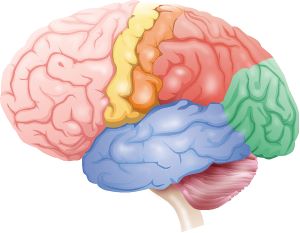 A new study published in the Journal of Translational Psychiatry looked at the spatiotemporal expression patterns of anxiety disorder-associated genes.
A new study published in the Journal of Translational Psychiatry looked at the spatiotemporal expression patterns of anxiety disorder-associated genes.
“There are a substantial number of neuroimaging and microstimulation studies that identify neural circuits linked to anxiety as a trait or specific anxious behaviors such as pessimistic decision-making,” study author Kalyani B. Karunakaran told us. “On the other hand, there are genome-wide association (GWA) and targeted gene sequencing studies that have identified genes linked to various anxiety disorders (ADs).”
What was lacking in the field was a connection between these two kinds of studies, a bridge to connect the neural circuitry-to-genes gap. The researchers sought to identify the regions where AD-associated genes are expressed. They hoped they would correspond to the neurocircuitry identified in the physiological studies and bridge the circuitry-to-genes gap.
“We certainly thought AD-associated genes would show high expression in regions identified in earlier studies as critical to anxiety etiology, such as the amygdala and the striatum,” Karunakaran told us. “However, we did not expect such a stark (and replicable) bifurcation of AD-associated genes into two clusters with distinct regional specificities. We were excited to detect this element of organization among the AD genes spread across disparate studies.”
The Amemori group is focused on the discovery and genetic manipulation of primate anxiety-related circuits, particularly the cortico-basal ganglia circuit. Studying the spatial expression patterns of AD-associated genes was crucial because it would help identify AD-related regions, characterize these regions further using single-cell technologies, and, with sufficient cell-type-level characterization, guide the development of primate models of AD. So, this study has essentially given the researchers, and they hope for other groups as well, data for future AD research.
“In our study, we attempted to capture the full spectrum of AD-associated genes,” Karunakaran told us. “This included genes harboring variants of suggestive and genome-wide significance from GWA studies and those from targeted gene sequencing studies. This produced a list of over 200 genes. We then extracted their microarray expression profiles in 232 adult brain structures from Allen Brain Atlas. We analyzed them using various clustering and enrichment methods. Further, we used a range of biological databases to annotate the regional clusters we derived from the microarray data. We used the RNA-sequencing data from BrainSpan Atlas to study how the expression profiles of the clusters varied across various developmental stages.”
The researchers found that AD-associated genes split into two clusters with distinct regional specificities: a limbic-associated spatial cluster highly expressed in the hippocampal formation and specific cerebral nuclei such as the claustrum, and a midbrain-associated spatial cluster highly expressed in the raphe nucleus and ventral tegmental area, and specific cerebral nuclei such as the central nucleus of the amygdala and the bed nucleus of stria terminalis.
Most importantly, the brain structures identified were the same as those responsible for regulating AD behaviors in earlier physiology research. The researchers could further link these gene clusters to specific anxiety-related behaviors, signaling pathways, region-specific gene networks, and cell types. All these hinted at two distinct neural circuits and neurophysiological systems regulating AD symptoms. They further found that the timing of expression of the two gene clusters was negatively correlated.
“We were surprised by the clear correspondence of the regional specificities of the two AD gene clusters to earlier physiology research,” Karunakaran told us. “Moreover, three additional clustering methods (apart from hierarchical clustering) and two independent expression datasets could replicate the clusters. These clusters persisted even when the AD gene set was restricted to genes confirmed to be impacted by AD-associated variants (through eQTL studies) or differentially expressed in post-mortem brain samples from individuals with AD.”
Karunakaran believes the research shows that AD-associated genes cluster in three areas in the human brain: the limbic system, the midbrain, and (specific) cerebral nuclei. Going forward, it would be crucial to focus on key structures in these areas and elucidate their role in producing AD symptoms using a combination of systems neuroscience, genetics, and bioinformatics studies. The researchers hope that many more GWA studies with variants reaching genome-wide significance will be available for analysis, which would help clarify our results further.
“Second, the druggable AD gene space remains to be explored in detail,” Karunakaran told us. “We hope the functional profiles of the two AD gene clusters will inform drug discovery and repurposing, a topic we would like to explore further. Third, the temporal expression patterns of our two AD gene clusters indicated that AD mechanisms are likely to be regulated in two critical stages, for example, late infancy and adulthood, and late prenatal stage and early childhood. This insight should help us think critically and perhaps even differently about AD onset, progression, and therapeutic interventions in critical windows.”
GWA studies with variants of genome-wide significance are available for post-traumatic stress disorder (PTSD), which was initially not included in the researchers’ set of AD subtypes due to its distinct classification in DSM-5. However, when they considered PTSD-associated genes in our analyses, they could further dissociate the midbrain-associated gene cluster into two clusters expressed in different subsets of midbrain structures. One of these clusters showed statistically significant enrichment for genes associated with PTSD and social anxiety disorder, essentially linking clusters of AD symptoms to specific gene clusters. So, examining PTSD genes is crucial to elucidating anxiety etiology.
Patricia Tomasi is a mom, maternal mental health advocate, journalist, and speaker. She writes regularly for the Huffington Post Canada, focusing primarily on maternal mental health after suffering from severe postpartum anxiety twice. You can find her Huffington Post biography here. Patricia is also a Patient Expert Advisor for the North American-based, Maternal Mental Health Research Collective and is the founder of the online peer support group - Facebook Postpartum Depression & Anxiety Support Group - with over 1500 members worldwide. Blog: www.patriciatomasiblog.wordpress.com
Email: tomasi.patricia@gmail.com